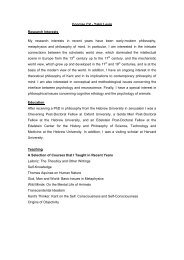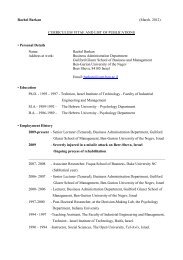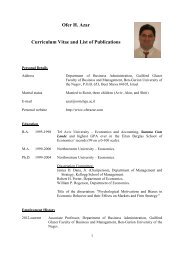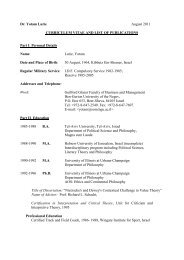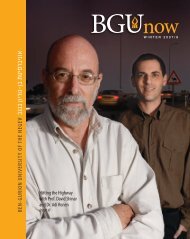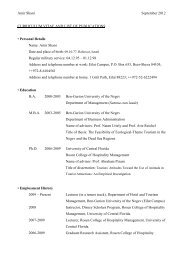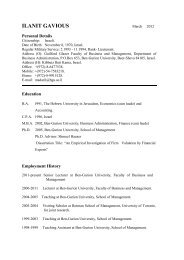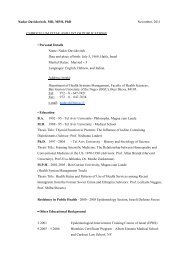Book of Abstracts
Book of Abstracts
Book of Abstracts
You also want an ePaper? Increase the reach of your titles
YUMPU automatically turns print PDFs into web optimized ePapers that Google loves.
34<br />
life cycle <strong>of</strong> the built facility. Integrative design processes ensure taking into account seismic aspects together with<br />
other matters <strong>of</strong> sustainability in order to make sure the building will not only be functional and energy efficient but<br />
also will be able to structurally survive in the event <strong>of</strong> an earthquake.<br />
For example, architectural decisions dealing with the geometry <strong>of</strong> the building and the location <strong>of</strong> different elements<br />
in the plan have a significant impact not only on the building's routine functionality and aesthetics, but also on its<br />
stiffness and dynamic response in the event <strong>of</strong> a major earthquake at some point in the future. From an energetic<br />
perspective, a seismically resistant configuration may encourage structural solutions which rely, for example, on less<br />
reinforcing steel and as a result may reduce the initial energy embodied in the building’s production – with the<br />
economic and environmental implications <strong>of</strong> that energy consumption manifest over an extended time frame.<br />
The aim <strong>of</strong> this study is to examine barriers to the integrated design <strong>of</strong> resilient buildings by looking at incentives<br />
and disincentives for non-linear co-design processes along the extended building supply chain. The study will use a<br />
novel research approach employing the Delphi technique, a systematic, interactive forecasting method which relies<br />
on panels <strong>of</strong> experts to identify potential and actualized relationships among industry actors.<br />
Desertification as Catastrophic Regime Shift: Empirical and<br />
Mathematical Aspects<br />
Desertification is commonly viewed as a dynamical transition from a productive stable state to an<br />
alternative less productive stable state. The transition can be induced by an environmental change or by a<br />
disturbance, and becomes feasible near an instability point <strong>of</strong> the productive state. The session will<br />
address mathematical aspects <strong>of</strong> such transitions, taking into account the possibility <strong>of</strong> the productive<br />
state being spatially patchy. Questions to be addressed include mechanisms <strong>of</strong> desertification, warning<br />
signals for imminent desertification and restoration <strong>of</strong> decertified areas. The session will also address<br />
field observations <strong>of</strong> vegetation patterns and pattern dynamics, and attempt confronting model predictions<br />
with empirical data.<br />
Desertification as a gradual regime shift in spatially extended ecosystems<br />
Golan Bel, Hezi Izhaq, Aric Hagberg and Ehud Meron; Department <strong>of</strong> Solar Energy; Ben-Gurion University <strong>of</strong> the<br />
Negev; Sede Boqer Campus, Israel; bei@bgu.ac.il<br />
Ecosystem regime shifts are conceived as abrupt global transitions from one stable state to an alternative stable state,<br />
induced by slow environmental changes. Spatially extended ecosystems, however, can also respond to local<br />
disturbances by the nucleation <strong>of</strong> small domains <strong>of</strong> the alternative state. Such a response can lead to gradual regime<br />
shifts involving front propagation and coalescence <strong>of</strong> alternative-state domains. When one <strong>of</strong> the states is spatially<br />
patterned, a multitude <strong>of</strong> intermediate stable states appears, ranging from holes in periodic patterns to localized<br />
states, giving rise to step-like gradual shifts. Vegetation dynamics in drylands is a spatially extended ecosystem that<br />
exhibits a bi-stability <strong>of</strong> patterned and uniform states. We demonstrate the existence <strong>of</strong> localized states in a<br />
vegetation model that captures two pattern-forming feedbacks, one associated with infiltration contrast between<br />
vegetated areas and bare soil and the other with root-shoot relationships. We further evaluate numerically a<br />
bifurcation diagram that shows the forms <strong>of</strong> the localized solution branches. It is shown that under certain climatic<br />
conditions, gradual regime shifts involving intermediate localized states, may take place. In addition, the effects <strong>of</strong><br />
the two feedbacks on the bifurcation diagram and, hence, on the nature <strong>of</strong> the regime shifts are studied. We show<br />
that the larger the root-shoot feedback, the more gradual is the degradation <strong>of</strong> the vegetation and the more abrupt is<br />
the recovery <strong>of</strong> the vegetation from localized states into a patterned state. We propose indicators to probe gradual<br />
regime shifts and suggest that a combination <strong>of</strong> abrupt-shift indicators and gradual-shift indicators might be needed<br />
to unambiguously identify regime shifts. Our results are particularly relevant to desertification in drylands where<br />
transitions to bare soil take place from spotted vegetation, and the degradation process appears to involve step-like<br />
events <strong>of</strong> local vegetation mortality caused by repeated droughts.



